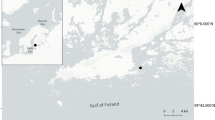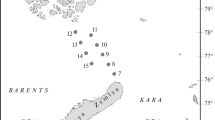Summary
In the eastern Weddell Sea on several transects from ice-covered, through ice melt, to open-ocean stations, total and heterotrophic bacteria were estimated to document an enhanced bacteriological biomass expected near the ice edge. The highest numbers of bacteria were found in melted ice cores, with 4.2·103 CFUml−1 and 1.1·107 Cells ml−1. Although brine from pore water samples average more than one order of magnitude less cells per ml, the highest bacterial production, 2.2·107 cells l−1 day−1, was recorded in brine samples. All quantitatively studied bacterial parameters were lower under the ice than in the ice samples but there were no clear vertical gradients in the water column. In the studied spring situation, sea ice occurrence seems to play only a minor role in the general distribution of the seawater bacterioplankton. The bacterial community structure was investigated by carrying out 29 morphological and biochemical tests on 118 isolated strains. The bacterial communities inhabiting Antarctic pack ice differ from those found in underlying seawater. Although non fermentative Gram-negative rods were always dominant in seawater, Vibrio sp. represented more than 25% of the strains isolated from some ice samples. The results clearly indicated that a large majority of the bacteria isolated from seawater must be considered psychrotrophic but that truly psychrophilic strains occurred in melted ice and brine samples.
Similar content being viewed by others
References
Ackley SF, Buck KR, Taguchi S (1979) Standing crop of algae in the sea ice of the Weddell Sea region. Deep-Sea Res 26A:269–281
Bhakoo M, Herbert RA (1980) Fatty acid and phospholipid composition of five psychrotrophic Pseudomonas spp. grown at different temperatures. Arch Microbiol 126:51–55
Bianchi A (1981) Distribution quantitative et qualitative des populations bactériennes à l'interface eau-sédiment. In: Daumas R (ed) Biogéochimie de la matière organique à l'interface eau-sédiment marin. CNRS, Paris, pp 269–274
Bjørnsen PK, Kuparinen J (1991) Determination of bacterioplankton biomass, net production and growth efficiency in the southern ocean. Mar Ecol Prog Ser 71:185–194
Bölter M, Dawson R (1982) Heterotrophic utilization of biochemical compounds in Antarctic waters. Neth J Sea Res 16:315–332
Bouvy M, Delille D (1988) Spatial and temporal variations of Antarctic and Subantarctic bacterioplankton. Neth J Sea Res 22:139–147
Buck KR, Garrison DL (1983) Protists from the ice-edge region of the Weddell Sea. Deep-Sea Res 30:1261–1277
Cota GF, Kottmeier ST, Robinson DH, Smith WO Jr., Sullivan CW (1990) Bacterioplankton in the marginal ice zone of the Weddell Sea: biomass, production and metabolic activities during austral autumn. Deep-Sea Res 37:1145–1167
Delille D (1987) Spatial distribution of coastal Antarctic seawater bacteria: relationship with avifauna. Polar Biol 8:55–60
Delille D (1990) Seasonal changes of subantarctic heterotrophic bacterioplankton. Arch Hydrobiol 119:267–277
Delille D, Bouvy M (1989) Bacterial responses to natural organic inputs in a marine subantarctic area. Hydrobiologia 182:225–238
Delille D, Mallard L (1991) Seasonal changes of Antarctic marine bacterioplankton Kieler Meeresforsch 8:213–218
Delille D, Perret E (1989) Influence of temperature on the growth potential of southern polar marine area. Microbiol Ecol 18: 117–123
Delille D, Bouvy M, Cahet G (1988) Short term variations of bacterioplankton in Antarctic zone: Terre Adélie area. Microbiol Ecol 15:293–309
El-Sayed SZ (1984) Productivity of Antarctic waters- a reappraisal. In: (eds) O Holm-Hansen, Bolis L, Gilles R Springer Berlin Marine phytoplankton and productivity. Lecture notes on coastal and estuarine studies, vol. 8. pp 19–34
Fryxell GA, Kendrick GA (1988) Austral spring microalgae across the Weddell Sea ice edge: spatial relationships found along a northward transect during AMBRIEZ 83. Deep-Sea Res 35:1–20
Fuhrman JA, Azam F (1982) Thymidine incorporation as a measure of heterotrophic bacterioplankton production in marine surface waters: evaluation and field results. Mar Biol 66:109–120
Garrison DL, Buck KR (1989) The biota of Antarctic pack ice in the Weddell Sea and Antarctic peninsula regions. Polar Biol 10: 211–219
Garrison DL, Sullivan CW, Ackley SF (1986) Sea ice microbial communities in Antarctica. BioScience 36:243–250
Garrison DL, Buck KR, Fryxell GA (1987) Algal assemblages in Antarctic pack ice and ice-edge plankton. J Phycol 23:564–572
Grossi SM, Kottmeier ST, Sullivan CW (1984) Sea ice microbial communities III. The seasonal development of algal-bacterial interactions in McMurdo Sound. Microbiol Ecol 10:231–242
Hagström A, Larsson V, Horsted P, Normark S (1979) Frequency of dividing cells, a new approach to the determination of bacterial growth rates in aquatic environments. Appl Environ Microbiol 37:805–812
Hanson RB, Lowery HK (1985) Spatial distribution, structure, biomass and physiology of microbial assemblages across the Southern Ocean frontal zones during the late austral winter. Appl Environ Microbiol 49:1029–1039
Hanson RB, Schafer D, Ryan T, Pope DH, Lowery HK (1983) Bacterioplankton in antarctic ocean waters during late austral winter: abundances, frequency of dividing cells, and estimates of production. Appl Environ Microbiol 45:1622–1632
Hauxhurst JD, Kaneko T, Atlas RM (1981) Characteristics of bacterial communities in the gulf of Alaska. Microbiol Ecol 7:167–182
Hobbie JE, Daley RJ, Jasper S (1977) Use of nuclepore filters for counting bacteria by fluorescence microscopy. Appl Environ Microbiol 33:1225–1228
Hodson RE, Azam F, Carlucci AF, Fuhrman JA, Karl DM, Holm-Hansen O (1981) Microbial uptake of dissolved organic matter in McMurdo Sound. Antarctica Mar Biol 61:89–94
Horner RA, Schrader GC (1982) Relative contribution of ice algae, phytoplankton, and benthic microalgae to primary production in nearshore regions of the Beaufort Sea. Arctic 35:485–503
Iniss WE, Mayfield CI (1979) Seasonal vaiation of psychrophilic bacteria in sediment from lake Ontario. Water Res 13:481–484
Inoué K, Komagata K (1976) Taxonomic study on obligately psychrophilic bacteria isolated from Antarctica. J Gen Appl Microbiol 22:165–178
Kottmeier ST, Sullivan CW (1988) Sea ice microbial communities 9. Effects of temperature and salinity on rates of metabolism and growth of autotrophs and heterotrophs. Polar Biol 8:293–304
Kottmeier ST, Grossi SM, Sullivan CW (1987) Sea Ice Microbial Communities. VIII. Bacterial production in annual sea ice of McMurdo Sound, Antarctica. Mar Ecol Prog Ser 35:175–186
Lizotte MP, Sullivan CW (1991) Photosynthesis-irradiance relationships in microalgae associated with Antarctic pack ice: evidence for in situ activity. Mar Ecol Prog Ser 71:175–184
MacCormack WL, Fraile ER (1990) Bacterial flora of newly caught Antarctic fish Notothenia neglecta. Polar Biol 10:413–417
MacMeekin TA, Franzmann PD (1988) Effect of temperature on the growth rates of halotolerant and halophilic bacteria isolated from Antarctic saline lakes. Polar Biol 8:281–285
Oppenheimer CH, ZoBell CE (1952) The growth and viability of sixty three species of marine bacteria as influenced by hydrostatic pressure. J Mar Res 11:10–18
Reichard W (1988) Impact of the Antarctic benthic fauna on the enrichment of biopolymer degrading psychrophilic bacteria. Microbiol Ecol 15:311–321
Rüger H-J (1989) Benthic studies of the northwest African upwelling region: psychrophilic and psychrotrophic bacterial communities from areas with different upwelling intensities. Mar Ecol Prog Ser 57:45–52
Simidu U, Taga N, Colwell RR, Schwarz JR (1980) Heterotrophic bacterial flora of the seawater from the Nansei Shoto (Ryukyu Retto) area. Bull Jpn Soc Sci Fish 46:505–510
Smith REH, Clement P (1990) Heterotrophic and bacterial productivity in assemblages of microbes from sea ice in the high Arctic. Polar Biol 10:351–357
Smith WO, Jr, Baumann ME, Wilson DL, Letsee A (1987) Phytoplankton biomass and productivity in the marginal ice zone of the Fram Strait during summer 1984. J Geophys Res 92:6777–678
Sneath PHA, Sokal RR (1974) The principles and practice of numerical classification. WH Freeman, San Francisco
Sokal RR, Michener CD (1958) A statistical method for evaluating systematic relationships. Univ Kansas Sci Bull 38:1409–1438
Staley JT, Irgens RL, Herwig RP (1989) Gas Vacuolate bacteria from the sea ice of Antarctica. Appl Environ Microbiol 55:788–795
Sugahara I, Lim LC, Hooi KK (1984) Heterotrophic bacterial population in tropical coastal waters. Bull Jpn Soc Sci Fish 50:1033–1036
Sullivan CW, Palmisano AC (1984) Sea ice microbial communities: Distribution, abundance and diversity of ice bacteria in McMurdo Sound, Antarctica, in 1980. Appl Environ Microbiol 47:788–795
Sullivan CW, Cota GF, Krempin DW, Smith WO Jr (1990) Distribution and activity of bacterioplankton in the marginal ice-zone of the Weddell Sea during austral spring. Mar Ecol Prog Ser 63: 239–252
Trousselier M, Legendre P (1981) A functional evenness index for microbial ecology. Microbiol Ecol 7:283–297
Wicks RJ, Robarts RD (1987) The extraction and purification of DNA labelled with [3H-methyl] thymidine in aquatic bacterial production studies. J Plankton Res 9:1159–1166
Author information
Authors and Affiliations
Additional information
Data presented here were collected during the European Polarstern Study (EPOS) sponsored by the European Science Foundation
Rights and permissions
About this article
Cite this article
Delille, D. Marine bacterioplankton at the Weddell Sea ice edge, distribution of psychrophilic and psychrotrophic populations. Polar Biol 12, 205–210 (1992). https://doi.org/10.1007/BF00238261
Received:
Accepted:
Issue Date:
DOI: https://doi.org/10.1007/BF00238261




